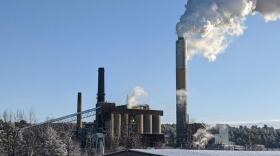Rotting food in landfills is contributing significantly to planet-warming methane emissions, according to a new federal report released this month.
The U.S. Environmental Protection Agency’s analysis shows food creates 58% of the yearly methane emissions from landfills, the equivalent of 50 million gas-powered passenger vehicles. From 1990 to 2020, nationwide methane emissions from landfilled food waste nearly tripled, the report found.
In Connecticut, food waste makes up about 22% of the state’s garbage, according to state estimates. That rotting food decomposes quickly, releasing methane, a potent greenhouse gas, which traps much more heat in the atmosphere than equivalent carbon dioxide emissions, accelerating climate change.
The problem of how to handle Connecticut’s wasted food gained new urgency last year when MIRA, a major trash-burning plant in Hartford, closed. The tens of thousands of tons of garbage that MIRA used to handle is now sent to out-of-state landfills, which state environmental officials say is unsustainable.
“We do feel that responsibility to manage the waste that's produced within the borders of the state, so that remains an objective of ours,” said Joe DeNicola, a senior policy advisor at the Department of Energy and Environmental Protection (DEEP). “And so diversion is the leading approach to achieving that.”
Connecticut has worked to divert food from landfills by setting up more than a dozen pilot programs to recycle food waste in cities and towns. DEEP says the pilots, which promote recycling of food scraps, have been successful and they hope the idea can grow.
“The residents are showing that they absolutely are able to separate their food waste,” DeNicola said. “And with some education programs, the contamination rates declined to the point where this material is suitable for anaerobic digestion, and composting.”
But overhauling the state’s waste strategy post-MIRA has been a challenge. This spring, lawmakers scaled back a proposal that would have positioned Connecticut toward ending trash exports out-of-state. The idea also would have increased waste collection fees to support municipal food scrap collection programs and held manufacturers financially responsible for wasteful packaging.
Lawmakers balked at many parts of the proposal, and Gov. Ned Lamont signed a heavily amended version of the idea into law this summer.
In a letter to lawmakers, Lamont criticized the amended legislation, saying it would divert some trash from landfills, but not nearly enough. And he said the law gives “no clear path for developing new disposal infrastructure.”
But Lamont says recycling food waste will be key to Connecticut’s future waste strategy. In towns that have tried pilot programs, he said, nearly one-third of food scraps got diverted from the trash.
“The success of those pilots and programs provides a clear path forward to a self-sufficient future where organics and packaging materials are not hauled to out-of-state landfills but instead are responsibly managed in state at a lower cost to residents,” Lamont said. “We can and must realize that future.”





